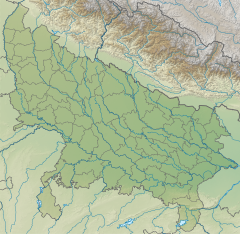Lahuradewa: Difference between revisions
Appearance
Content deleted Content added
Fixed typo Tags: Reverted Mobile edit Mobile web edit |
correcting info from ref |
||
| Line 13: | Line 13: | ||
'''Lahuradewa''' (Lat. 26°46'12" N; Long. 82°56'59" E) is located in [[Sant Kabir Nagar District]], in Sarayupar (Trans-Sarayu) region of the Upper Gangetic Plain in [[Uttar Pradesh]] state of [[India]]. The Sarayupar Plain is bounded by the [[Sarayu]] River in the west and south, Nepalese [[Terai]] in the north and the [[Gandak]] River in the east. |
'''Lahuradewa''' (Lat. 26°46'12" N; Long. 82°56'59" E) is located in [[Sant Kabir Nagar District]], in Sarayupar (Trans-Sarayu) region of the Upper Gangetic Plain in [[Uttar Pradesh]] state of [[India]]. The Sarayupar Plain is bounded by the [[Sarayu]] River in the west and south, Nepalese [[Terai]] in the north and the [[Gandak]] River in the east. |
||
The site is noted to have been occupied as early as |
The site is noted to have been occupied as early as 9,000 BCE,<ref>{{cite book|url=https://books.google.com/books?id=vWbwAwAAQBAJ&pg=PT1335&dq=Lahuradewa|title=The Cambridge World Prehistory|publisher=Cambridge University Press|author1=Colin Renfrew|author2=Paul Bahn|page=1335}}</ref> and by 7,000 BCE it provides the oldest evidence of [[ceramics]] in [[South Asia]].<ref>{{cite book|url=https://books.google.com/books?id=2HMTBwAAQBAJ&pg=PA250&dq=Lahuradewa+9000&hl=en&sa=X&ved=0ahUKEwiHz-mRqs3WAhUKsI8KHS5NDj8Q6AEIRzAF#v=onepage&q=Lahuradewa%209000&f=false|page=250|author1=Peter Bellwood|author2=Immanuel Ness|publisher=John Wiley & Sons|title=The Global Prehistory of Human Migration}}</ref><ref>{{cite book|url=https://books.google.com/books?id=7xv-CwAAQBAJ&pg=PA350&dq=Lahuradewa+7000&hl=en&sa=X&ved=0ahUKEwiy19v2qM3WAhXBqo8KHS8IC3sQ6AEIQDAE#v=onepage&q=Lahuradewa%207000&f=false|title=A Companion to South Asia in the Past|publisher=John Wiley & Sons|page=350|author1=Gwen Robbins Schug|author2= Subhash R. Walimbe}}</ref> |
||
Excavations reported earliest archaeological sites in South Asia for cultivation of [[rice]], with Lahuradewa Period IA giving samples that were dated by AMS [[Radiocarbon dating|radiocarbon]] to the 7th millennium BCE.<ref>Early Farming at Lahuradewa; [[Rakesh Tewari]], R.K. Srivastava, K.S. Saraswat, I.B. Singh, K.K. Singh [http://archaeology.up.nic.in/doc/efl_rtrk.pdf]</ref> |
Excavations reported earliest archaeological sites in South Asia for cultivation of [[rice]], with Lahuradewa Period IA giving samples that were dated by AMS [[Radiocarbon dating|radiocarbon]] to the 7th millennium BCE.<ref>Early Farming at Lahuradewa; [[Rakesh Tewari]], R.K. Srivastava, K.S. Saraswat, I.B. Singh, K.K. Singh [http://archaeology.up.nic.in/doc/efl_rtrk.pdf]</ref> |
||
Revision as of 05:23, 13 May 2021
Location of Lahuradewa site
Lahuradewa (Lat. 26°46'12" N; Long. 82°56'59" E) is located in Sant Kabir Nagar District, in Sarayupar (Trans-Sarayu) region of the Upper Gangetic Plain in Uttar Pradesh state of India. The Sarayupar Plain is bounded by the Sarayu River in the west and south, Nepalese Terai in the north and the Gandak River in the east.
The site is noted to have been occupied as early as 9,000 BCE,[1] and by 7,000 BCE it provides the oldest evidence of ceramics in South Asia.[2][3]
Excavations reported earliest archaeological sites in South Asia for cultivation of rice, with Lahuradewa Period IA giving samples that were dated by AMS radiocarbon to the 7th millennium BCE.[4]
References
- ^ Colin Renfrew; Paul Bahn. The Cambridge World Prehistory. Cambridge University Press. p. 1335.
- ^ Peter Bellwood; Immanuel Ness. The Global Prehistory of Human Migration. John Wiley & Sons. p. 250.
- ^ Gwen Robbins Schug; Subhash R. Walimbe. A Companion to South Asia in the Past. John Wiley & Sons. p. 350.
- ^ Early Farming at Lahuradewa; Rakesh Tewari, R.K. Srivastava, K.S. Saraswat, I.B. Singh, K.K. Singh [1]

